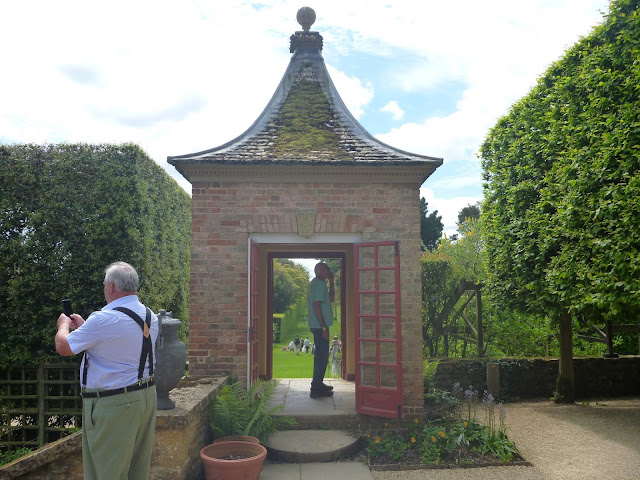A visit to Hidcote garden on a warm, sunny day is a real treat - Hidcote is at its best in the spring when the whole place is a riot of colour.
Hidcote is an Arts and Craft garden, the product of a socialist ideology which began in the late 19th century, as an antidote to the advancing technology and materialism of Victorian society and which promoted a more traditional focus on the craftsperson and artist. Arts and Crafts Gardens were seen as an extension of the house where architectural elements of the building were echoed in the garden, creating a series of formal 'outside rooms' that were viewed from the house. Beyond these 'outside rooms' the garden gave way to the landscape - rock gardens led to woodland glades and wild areas with rustic paths and water gardens.
An Arts and Crafts garden has the following characteristics: enclosures that provide small intimate spaces, anticipating surprises around the corner; the use of traditional materials, such as stone and oak, used in an imaginative way to construct walls and steps; ornamental structures such as gazebos, formal pools, fountains, sundials; carefully considered plant choice where plants are given freedom to grow within borders, culminating in the famous over-flowing look of an English garden, with carefully considered colours; yew hedges are favoured creating a dense backdrop and because yew accommodates topiary.
Lawrence Johnston incorporated all of the above in the creation of Hidcote.
We started our walk with the series of 'outside rooms' that surround the house
and which include mature trees
each 'room' is surrounded by hedges with narrow gaps that give way to the next 'room' or to the thatched cottage in this photograph
the planting is dense and carefully planned
view of the house

a clearing
iris dominates at this time of year
and so we moved on from room to room
and arrived in the area dominated by the fountain
washing up liquid? Probably
some of the planting is very carefully planned
while in other areas nature has been allowed to run its course
The gardens were very busy and we felt the need to move away from people so we took a path that would lead to what Johnston called the 'wilderness'
which leads to an open area that affords great views of the Cotswold countryside
these gates led us up back to the formal gardens
along this long vista with one of the gazebos at the end
the rhododendrons in full blossom
and interesting planting on the ground
it's such a pleasure wandering around here
lots of poppies, but unfortunately, the Himalayan blue poppy which was one of the reasons I wanted to visit at this time of year, had not flowered yet
a small stream runs through the garden
back to the long vista
but we got sidetracked by this series of gaps in the hedge
a series of topiary that forms paths
this is a slow walk allowing for frequent stops to admire the planting
We came to a clearing where a lot of people had chosen to picnic
this little boy spent a long time trying to entice the sheep to come closer
Two rows of trees that just invite you to walk under their shade
and then we got to the first gazebo which was built by Lawrence Johnston in 1915
and then the second one, facing the first. The placement of the two gazebos adds to the structure and design of the two central vistas in the garden.
We then moved on to the second vista

which leads on to the woods.
Bliss!
Small, but perfectly formed
a cool oasis after the heat in the gardens
we wandered here for a while
left the woods
and made our way to the green house
and the lily pond which was covered with chicken wire in an attempt to protect the newts from the ducks.
More iris here
stopped to admire more iris
such inspired planting
two wisteria trees at the end of the path
and then we entered the orchard
moved on to the tool shed
a thatched cottage
and we had come full circle back to the house
a lilac bush
and the handkerchief tree which I remembered from our last visit



































































Hidcote is a wondrous place indeed. My husband once declared it to be his favourite garden. I always think about how many hours of work it must take to maintain such an effortless-seeming result!
ReplyDeleteI am sorry that you missed the blue Meconopsis.
I think I agree with your husband, Olga. It's so wonderful being there, and as you say, so many hours and hours of work.... I am also awed by the knowledge and skill and vision that is required to create such a garden.
DeleteAha! I now know the name for the blue Meconopsis! It's the only garden I have ever seen one, and I was really looking forward to it. Never mind, next year.
Still have not visited the garden near Oxford that you wrote about a while ago - it will have to wait until the autumn now but I am looking forward to it.
You will have to plan a visit to the Scottish Borders next June - to Dawyick Botanic Garden. https://www.rbge.org.uk/visit/dawyck-botanic-garden/
DeleteMeconopsis love the conditions in Scotland, and the Scottish Borders are not too far to go.
Dawyick looks wonderful, Olga, so there's another addition to my list. Thank you.
Delete